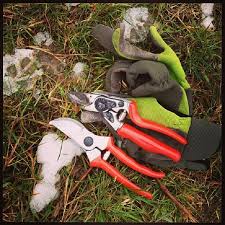Winter Garden Chores

By Dudley Vines
Winter is a slow time for gardeners. Many folks enjoy looking through nursery catalogs and planning next year’s garden. Winter is also a good time to clean, sharpen, oil, and otherwise maintain your garden tools. And hopefully, you’re enjoying some of your produce from last year, if you canned or froze it. Did you know that the Extension Service offers free classes and facilities for canning? Educational bulletins are available on the http://bernalilloextension.nmsu.edu/mastercomposter/index.htmlwebsite and here’s the canning center website.
What else might gardeners do in the winter? Here are some suggestions:
1. Clean up and dispose of leaves. There may be some perennials that you want to leave some leaves piled around for winter protection, but if leaves are blown up in piles against your fence, why wait till spring to start cleaning up? Your yard will look better, and you’ll have less work in the spring. Maybe you prefer to rake leaves several times during the Fall so your yard always looks great. Myself, I like to let them all fall and dry up, and then I clean up everything at once on a sunny day in December.
If you don’t compost at home, disposing of leaves and garden waste can be a bit of a problem, so fill your trash bin once a week and let them haul it away for you. If you have a pickup truck, you can haul your debris to the county landfill (the green waste fee is very modest) but those of us without trucks can let the trash man take it. I don’t fool around with plastic bags; wait until the leaves are really dry and crispy so you can crush them down in your trash bin. You might have to spread your leaf cleanup over a few weeks if your trash bin can’t hold it all at once. But, hey – who’s in a rush?
2. Prune trees. January is a wonderful time to prune trees. And you learned how to prune in SCMG class. The trees are dormant, and you’ve got the time, so get ‘er done. In this case, once again, your trash bin can serve you well in disposing of the waste.
Actually, it would be great if you started composting at home. The Sandoval County Master Composters conduct classes all the time, and compost is a valuable commodity in the garden. If you’re not into composting, and you have a truck (or a friend with a truck), I encourage you to haul garden waste to the Sandoval County landfill at 2700 Iris Road in Rio Rancho and toss it in the green waste pile, because there they compost on an industrial scale and sell the compost cheap. But if you don’t, instead prune one or two trees a week and put the debris in the waste bin. I cut everything up into pieces small enough to fit in the bin using my pruning saw and pruning shears. It’s a little work but I need the exercise and fresh air. And spreading the work over a few weeks makes it easier.
3. Spray trees with dormant oil. You might
do this in February before new growth starts. Dormant oil eliminates overwintering insects and insect eggs. No leaves or limbs to dispose of for this task. Be sure to read and follow all directions on the label. Some horticultural oils require temperatures to remain above freezing for 24 hours. Since you spray dormant oil with a hose-end sprayer, you need to pick a sunny day when the temperature is warm enough to unroll the hose and turn on the water (hopefully you drained your garden hose and coiled it up at the beginning of winter, and covered your outdoor faucets). Just connect the hose and spray the trees, and then drain the hose and cover the faucet again because, after all, it’s not springtime yet. Your trees will thank you.
In March and April, garden cleanup starts in earnest and you’ll be glad you got rid of the leaves and pruned your trees already, and you’ll have room in the trash bin for the material you prune from your perennials. And think about learning to compost because it is a noble undertaking.
